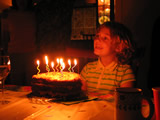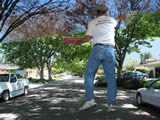
The Move to Digital
Most people enjoy taking pictures. Using traditional film cameras has become an increasingly dissatisfying experience. In today's age of instant gratification, who wants to wait to get their pictures back? As the price of digital cameras drops and the quality of image improves, it is hardly surprising to learn that in 2003, for the first time, digital cameras outsold film cameras.
For someone who has enjoyed photography, the move to digital offers some very appealing benefits, such as:
- Instant results
- You no longer need wait to see if you got a good picture. This has got to be one of the biggest appeals of digital photography!
- No cost barrier
- Once you have invested in the initial cost of the camera, there is virtually no cost in taking a picture. Not sure if you had the shot? Take another one. Not quite right on the exposure? Take another one. If you don't like them you can always delete them and take more. Take pictures all day long and delete them all if you like. It cost you nothing!
- An excellent learning environment
- Learn how to take good pictures. Take a picture. Change a setting. Take another picture. Reframe the shot. Learn what works. The shots are free and you have instant results!
- Safer storage
- Today it's easy to duplicate your digital pictures. Put them all on a CD. Make copies of the copies. There's no degradation in quality and no lost negatives.
- The digital darkroom
- After taking the picture, you now have many ways to modify it: Fix problems, make composites or montages; let your creativity run free in the medium of digital images.
- Natural lighting
- One of my favorite things about digital cameras is that you can capture scenes using natural light instead of using a flash every time. This isn't because digital cameras are better in low light — in fact they are usually worse since you don't have the option of buying low-light film — rather, it is because you can see the results of your picture immediately and make adjustments until you get just the picture you want.
Welcome to the wonderful world of digital photography. Whether you are an experienced digital photographer or just looking into getting your first digital camera, this site can help make you a better photographer. I have collected and illustrated a variety of techniques that will give you some insight into the possibilities of digital photography. Along the way, I have also amassed information on how to compose your picture, which should make for interesting reading even if you just want to take better film pictures.
Digital vs. Film
As digital cameras boast ever increasing pixel count, it begs the question: When will digital cameras equal film cameras in picture quality? The surprising answer: Some already have!
35 millimeter film contains effectively around 20 million pixels (megapixels), compared to digital cameras that typically have around 4-10 megapixels. But pixel density is not the whole story. The quality of the image must also be taken into account. Film is made up of microscopic particles of various size. As the picture is enlarged however, these particles become more visible in what we call grain. Digital photographs, when properly exposed, have no grain at all, so their perceived quality is much greater, all else being equal. The fact is that a mere 6 megapixels is all that is needed in a digital image to equal a 35-millimeter photograph, and there are prosumer cameras already available for under $1000 that have more than that!About Me
My name is Carl Ferreira, and I have been taking digital pictures for several years.
As an engineer, I was interested in learning about the workings of digital photography and especially digital image processing. As a long-time user of Adobe's Photoshop, I have become convinced that there is hardly a digital photograph that cannot be improved through careful use of the 'digital darkroom'.
Feel free to contact me if you have any questions.
My Camera
My favorite camera is the Canon G3, a 4-megapixel camera which has been extremely satisfying. Although I have also enjoyed using the Canon G2 (a slightly less advanced model), I have not found any other camera that seems to have a better price-to-feature ratio, although the latest cameras appearing on the market are offering features that are very interesting!
Recently, I moved up to a Canon 20D, chosen once again for the great price-to-feature ratio. The move to a DSLR is not without its trade-offs. My compact G3 is still used and has not been supplanted by the 20D; both cameras have their place! In the section on camera features I will speak more about this.
About the Pictures
All photos that appear on this website were taken by me with either a Canon G2 or Canon G3 camera, unless otherwise noted. Adobe Photoshop™ was used to edit all pictures.
All images are copyright © 2003-2007 by Carl Ferreira.








